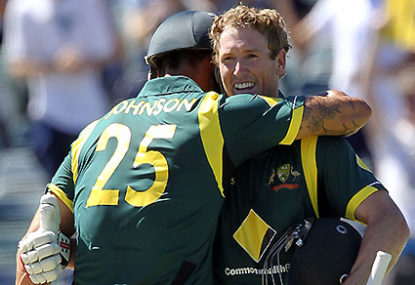George Bailey must be strongly considered for Australia’s Ashes squad. Granted, in almost any previous era he would not have been close to representing the Australian Test team.
But the Aussies are in a mad scramble to identify three batsmen for the next Ashes squad to complement the seemingly-fixed top five of Rogers, Warner, Watson, Clarke and Smith.
Australia’s batting stocks are so weak the selectors are believed to have given serious thought to playing Matthew Wade as a specialist batsman in the last Ashes.
Wade is generously gifted with the blade but has never even played as a frontline batsman at first-class level, a role which carries far greater pressure than slugging runs at number seven.
Consider also that Phil Hughes remains a strong chance to retain his spot in the Ashes squad despite having averaged just 21 in his past six Tests.
So too does Usman Khawaja, who is yet to prove himself at Test level, averaging 25 after nine matches.
Meanwhile, the two most promising batsmen in Australia, Tasmanian opener Jordan Silk and NSW top order dasher Nic Maddinson, are only 21 years old and would clearly benefit from further development at Shield level.
Silk has played just five first-class games, while Maddinson’s recent barnstorming efforts for Australia A belie the fact he hasn’t been a consistent run maker for NSW.
There is a serious dearth of options.
Bailey need only have put together a respectable Shield season last summer and he would very likely have made the last Ashes squad.
Instead he faltered, scoring just 256 runs at 18.
Bailey’s overall first-class record also falls short of what you would expect from a prospective Test batsman – just under 6000 runs at an average of 38, with only 14 tons from 96 matches.
When assessing Bailey’s first-class career, however, it should be kept in mind how much cricket he has played on the lively decks at Bellerive.
It is commonly argued that the bowling returns of his Tasmanian teammates Jackson Bird, James Faulkner and Luke Butterworth are flattered by the helpful home surface.
So it is only fair that Bailey’s record is also interpreted in light of the challenging conditions he has often faced.
Prior to last season’s disastrous campaign, Bailey had scored 1876 runs at 43 in his previous three Shield seasons.
Considering he played about half his games at Bellerive over that period, it was a fine return.
In normal circumstances, there is no doubt a player with recent first-class form as poor as Bailey’s would not receive Test selection.
But the selectors have taken punts on several other, less deserving players this year.
None of Ashton Agar, Glenn Maxwell or Xavier Doherty earned their recent Test caps through undeniable first class performances.
They also could not point to the sustained success at ODI level which Bailey has had.
I have always been loathe to use ODI form as a justification for Test selection.
This approach has contributed to some poor decisions by the selection panel in the past few years.
I do think, however, that the introduction of two new balls in ODI cricket has made the efforts of batsmen more relevant to first class cricket.
Whereas previously the white ball lost its shine and pronounced seam after about 15 overs, it now often offers movement through the air and off the pitch until up to 30 overs into the innings.
Bailey has passed 1000 ODI runs and boasts an impressive average of 48. He is only getting better too, having averaged 56 over his past 20 outings.
Most importantly, Bailey has swiftly built a reputation as a trouble shooter in ODIs.
Six of his nine scores of above 50 have come when he has arrived at the crease with Australia in trouble.
In his most recent match, the Aussies were 3-51 when Bailey came out to bat and 4-57 soon after as England’s quicks exploited the extravagant pace and bounce offered by the Cardiff pitch.
Bailey tamed the tricky surface en route to cracking 87 from 91 balls and helped Australia post a somewhat competitive total of 215.
These are the sorts of innings which were played with regularity by the recently-retired Mike Hussey, who perfected the art of rescuing Australia from perilous situations in all formats.
Bailey has effectively covered for the loss of Hussey at ODI level. But what Australia really needs is a replacement for the left hander at number six in Tests.
Ideally, a number six Test batsman should possess the dual capabilities of either steadying the side following a collapse or ramming home the advantage once the top order sets a strong platform.
A circumspect and classical batsman, Hussey was well equipped to graft in an effort to nurse Australia into a respectable position after the loss of back-to-back wickets.
Yet he was equally adept at dominating attacks should his side be pushing for quick runs.
Bailey has displayed at ODI level he too can perform both of these roles. He clearly possesses a sound temperament.
The Aussie T20 skipper should be made captain of Australia A for their match against England in the lead up to the first Test in Brisbane.
If he prospers in that outing and the two Shield matches he will be available to take part in before the series, he should be included in Australia’s squad.
Bailey may just be the best of a poor bunch.





























































































